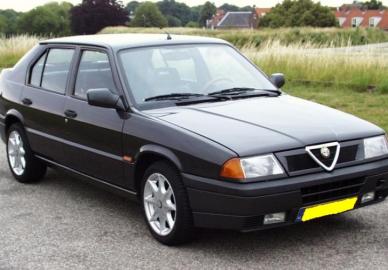Alfa Romeo 33

The history of the Alfa Romeo 33
The Alfa Romeo 33 is a small family car produced by the Italian automaker Alfa Romeo between 1983 and 1995. It was essentially an evolution of its predecessor, the Alfasud, which was based on the same floorplan, chassis and mechanicals albeit with some minor modifications. The 33 was discontinued in 1994 and replaced by the Alfa Romeo 145 and 146, which used the same boxer engines but built around an entirely new platform based on the Fiat Tipo.
The 5-door hatchback version was launched in 1983, and a station wagon version (initially badged Giardinetta, later badged SportWagon) was introduced the following year at the same time as a four-wheel drive version of the hatchback. The hatchback was styled by the Centro Stile Alfa Romeo, Ermanno Cressoni, while the station wagon was designed by Pininfarina.
The 33 became renowned for its nimble handling and powerful boxer engines, but also became equally well-known for its unreliable electronics and tendencies to rust (a frequent complaint on Italian cars in general at the time). Another issue was its braking and increased unsprung weight — the Alfasud's inboard front disks (mounted on the gearbox) had been moved to the more common outboard disks (mounted on the wheel hubs). The rear disks of the Sud's four-wheel disk arrangement had also been replaced with drums from the Nissan Cherry, as used on the Arna.
The 33 has a unique place in Alfa Romeo history - nearly 1 million of these cars were produced internationally.
During its 11 year lifespan the 33 saw two restyles; In consequence Alfisti tend to label each styling trend of the 33 after the flagship vehicle produced by Alfa Romeo at that time.
The First 33's are sometimes referred to as 'Alfa 90' 33s, as they most resemble that car. Further re-styles were to follow: a mild one in autumn 1986 (the Series II), when the 1.7 litre engine was introduced and a revised interior; these are known as 'Alfa 75' 33s. Later followed a much more extensive facelift in the end of 1989 (the Series III), with a revised interior, the introduction of fuel injection, the 1.7 litre engine upgraded to include a 137 PS (101 kW; 135 hp) 16 valve version, and a heavily restyled exterior, in line with the new Alfa "family look" established by the flagship 164. Also new four wheel version was introduced called the Permanent 4, which was renamed to Q4 starting from 1992. The last 33s are known as either 'Nuova' or '164' 33s for their resemblance to that model. These models are particularly prized by Alfisti for their performance and sophistication. Late production 33s also do not suffer from the rust problems of their ancestors, as their frames are galvanized in the manner Alfa introduced with the 164.
Alfa Romeo for sale
- Alfa Romeo 75
-
1990 Flemish Brabant
 EURO14,500Trade sale Views: 3250
EURO14,500Trade sale Views: 3250 - Alfa Romeo 147
-
2005 Cambridgeshire
 GBP14,995Trade sale Views: 1900
GBP14,995Trade sale Views: 1900 - Alfa Romeo 211
-
1969 London
 POATrade sale Views: 9772
POATrade sale Views: 9772 - Alfa Romeo 1750
-
1968 North Brabant
 POATrade sale Views: 4627
POATrade sale Views: 4627 - Alfa Romeo 1900
-
1958 Brussels-Capital Region
 EURO32,000Private sale Views: 4940
EURO32,000Private sale Views: 4940 - Alfa Romeo 2000 Spider
-
Lancashire
 POATrade sale Views: 9043
POATrade sale Views: 9043

